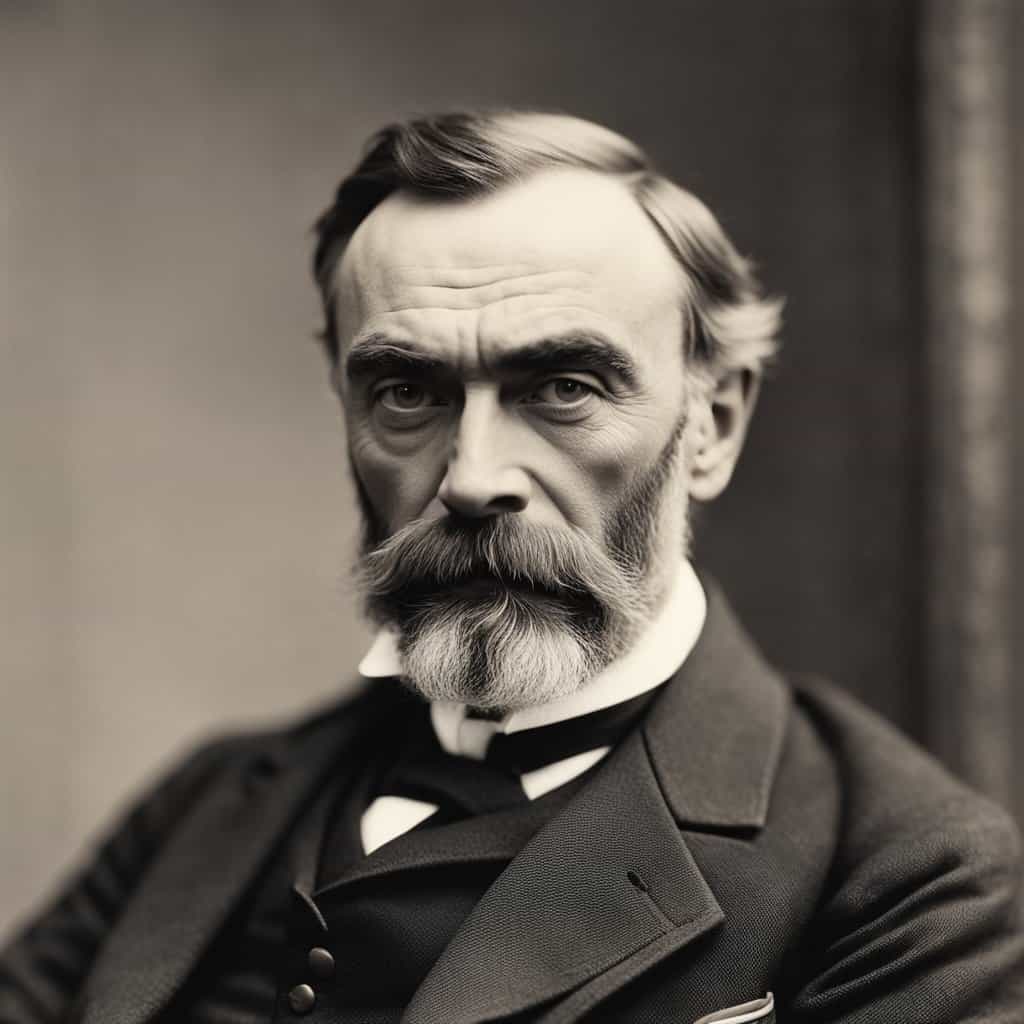Alfred Nobel didn’t just invent dynamite; he made a fortune at a mind-blowing equivalent of over $160 million today. But how did a Swedish chemist and engineer amass such dynamite dollars?
And more intriguingly, how did that wealth forge one of the world’s most iconic accolades? Nobel’s tale is more than numbers in a bank account—a saga of innovation, influence, and international acclaim.
Ready to unpack the explosive net worth and the legacy it built? Dive in!
Early Life and Education
Born in Stockholm, Sweden, on October 21, 1833, Alfred Nobel wasn’t just any ordinary child. The third son of inventor and engineer Immanuel Nobel, young Alfred was destined for brilliance.
Early on, his obsession? Explosives. By 1842, the Nobels were in St. Petersburg, Russia, with his father’s thriving engineering firm setting the stage for Alfred’s learning. He studied at the Jacobs Apologistic School, and honed his chemistry skills under Professor Nikolai Zinin at the University of St. Petersburg.
Fast forward to 1859, and nitroglycerin entered the Nobel world. Italian chemist Ascanio Sobrero discovered that this liquid had explosive potential but was wildly unstable. Alfred’s genius? Taming its volatile nature, leading to the world-changing invention of dynamite.
But he didn’t stop there. Gelignite, ballistite, and another staggering 350 patents showcased his inventive prowess. Yet, behind the inventions was a multi-faceted man. Fluent in multiple languages, an avid poet, playwright, and a respected member of royal academies.
Career and Inventions
The Swedish innovator was a force of nature. Boasting over 350 patents, he’s famed for dynamite, an explosive game-changer for construction and mining.
But where did this fascination with booms begin? The spark ignited in his family’s arms factory, where he pinpointed the peril of nitroglycerin’s volatile nature and transformed it into the more transport-friendly dynamite, setting off a revolution in building and mining.
Nobel also dabbled in clean energy, envisioning a world with an efficient gas meter. Artificial silk and leather? He was on it, championing sustainable fashion. He was an inventor and a visionary, molding the future of industry and commerce.
Establishment of Nobel Prizes
Upon his passing in 1896, Nobel’s vast treasure wasn’t hoarded but generously bequeathed to recognize global brilliance. Enter the Nobel Prizes—coveted accolades spotlighting prowess in physics, chemistry, medicine, literature, and peace. As a nod to his enduring impact, 1968 saw the birth of the Nobel Memorial Prize in Economic Sciences.
Fast forward to 1900, the Nobel Foundation emerged with a singular mission: preserving Nobel’s vision and orchestrating these annual accolades. Operating in Sweden, the foundation is the guardian of Nobel’s legacy, ensuring that every award aligns with his original wishes.
Every December 10, the world pauses to honor the creme de la creme in Stockholm, with an Oslo detour for the Peace Prize. Beyond the recognition, laureates receive a medal, a diploma, and a sum that’s a testament to the Nobel Foundation’s savvy investments.
The clout of a Nobel Prize? Unparalleled. Having graced some of history’s brightest minds and visionaries, it’s the gold standard of achievement. Sure, there’ve been murmurs of bias or political play, but the Nobel’s luster isn’t dimmed. It stands as an emblem of global excellence and aspiration.
Business Ventures
Alfred Nobel was not only a scientist but also a successful businessman. He owned several companies and factories that contributed to his immense wealth. Here are some of his most notable business ventures:
- Armaments Factories: He established an armaments factory in Sweden and expanded operations to other countries, including Russia, where he had a significant armaments factory in St. Petersburg. The factory produced weapons and explosives that were used in wars and conflicts around the world.
- Bofors: A Swedish company that produced cannons and other weapons. Nobel acquired the company in 1894 and transformed it into a significant player in the arms industry. Bofors became known for its high-quality products and was a significant supplier to the Swedish military.
- Branobel: He had a 3.8% share in a Russian oil company called Branobel, one of the world’s largest oil companies at the time. Nobel’s investment in Branobel made him wealthier and helped him to finance his various philanthropic projects.
Alfred Nobel was a shrewd businessman who knew how to make money. He also succeeded in the arms and mining industries and other ventures, such as paper production and engineering.
Personal Life and Relationships
Though amassing fame and fortune, Alfred Nobel led a notably private life. His heart, unbound by marriage, did flutter for two women: Bertha Kinsky and Sofija Hess. Yet, no wedding bells rang.
Tragedy scarred Nobel early on, with the explosion that claimed his brother’s life in 1864 casting a long shadow, possibly deepening his bouts of depression. From this darkness emerged a light: the invention of dynamite.
Paris and Italy often heard Nobel’s footsteps, with factories under his name and a cherished villa in San Remo. Yet, amidst these settings, he remained a portrait of solitude, often opting for the company of his thoughts over social galas.
Death and Legacy

In the serene setting of Sanremo, Italy, in 1896, Alfred Nobel took his last breath. But with his passing, the world was poised for a monumental revelation—his will. But Nobel’s will wasn’t met with universal applause. The absence of legal counsel during its drafting and the sidelining of some kin led to legal tussles.
Beyond his substantial wealth was a directive to champion global pioneers in physics, chemistry, medicine, literature, and peace through the Nobel Prizes. Key to this legacy was Ragnar Sohlman, Nobel’s confidante.
With a zeal to crystallize Nobel’s vision, he championed the creation of the Nobel Foundation, which was central to the Prize administration. Today, Stockholm hosts the award ceremonies and the Nobel Museum.
Net Worth Analysis
In 1896, the world bid farewell to Alfred Nobel, but his monumental wealth ensured his name would resonate for generations. Per the Nobel Peace Prize archives, Nobel’s colossal 31 million Swedish kronor legacy—equivalent to a staggering over $160 million today—stood as one of the era’s grandest personal fortunes.
Instead of distributing this mammoth estate traditionally, Nobel’s vision was crystal clear: his fortune would fuel a legacy safeguarded in low-risk securities. Enter the Nobel Foundation in 1900, the torchbearer ensuring Nobel’s will shines on.
It’s evident that Nobel wasn’t merely an inventor and property mogul. The man knew the art of money. His knack for nestling his riches in stable securities showcased an investor’s acumen, optimizing growth and fortifying his wealth.
Impact on Science and Industry

The legacy of Alfred Nobel stands colossal in the annals of science and industry. With a portfolio boasting over 350 patents and several trailblazing companies.
Venturing into high-pressure chemistry, Nobel delved deep into the mysteries of substances under intense pressure. Modern plywood owes a nod to him, now a mainstay from our homes to construction sites.
Yet, witnessing the havoc some of his inventions could wreak steered Nobel toward pacifism. He envisioned a world where innovations spurred peace, leading to the birth of the Nobel Prize accolades honoring strides in peace, literature, physics, chemistry, and medicine.
Today, these prizes spotlight luminaries, amplifying the essence of scientific breakthroughs and peace initiatives. But more than just recognition, they underline the power and responsibility of innovation.
Historical Context
During the Crimean War, Alfred Nobel’s father supplied the Russian army with mines, which were used greatly against British and French forces. This experience may have influenced Alfred Nobel’s decision to develop a safer and more stable explosive.
In addition to his work in explosives, Alfred Nobel was also involved in developing the synthetic dye industry. He invested in producing synthetic indigo used to dye denim and other fabrics.
Frequently Asked Questions
What was Alfred Nobel’s net worth at the time of his death?
Alfred Nobel’s net worth at the time of his death in 1896 was estimated to be around 31 million Swedish crowns, equivalent to approximately 160 million US dollars in today’s currency.
What was the value of the Alfred Nobel estate left in his will?
When Alfred Nobel passed away, he left behind a fortune that was then one of the world’s most enormous private fortunes. The estate’s value left in his will was estimated to be around 31 million Swedish crowns.
How did Alfred Nobel accumulate his wealth?
Alfred Nobel was a Swedish scientist, inventor, and entrepreneur who made his fortune through his inventions and businesses. He is best known for inventing dynamite and revolutionizing the construction and mining industries.
What did Alfred Nobel do with his wealth during his lifetime?
Alfred Nobel was a philanthropist who used his wealth to support various causes and organizations. He was particularly interested in promoting peace and international cooperation and established the Nobel Prizes to recognize individuals who made significant contributions to these fields.
What were the specific provisions of Alfred Nobel’s will?
In his will, Alfred Nobel specified that the bulk of his fortune should be used to establish the Nobel Prizes, awarded annually to individuals who have made outstanding contributions to physics, chemistry, medicine, literature, and peace. He also stipulated that the prizes should be awarded by committees appointed by the Swedish Academy of Sciences, the Karolinska Institute, and the Norwegian Nobel Committee.
What is the estimated value of the Nobel Prize today?
The Nobel Prize is one of the world’s most prestigious awards, and the value of the prize money has increased significantly over the years. In 2017, the value of the Nobel Prize was 9 million Swedish crowns, equivalent to approximately 1 million US dollars.



